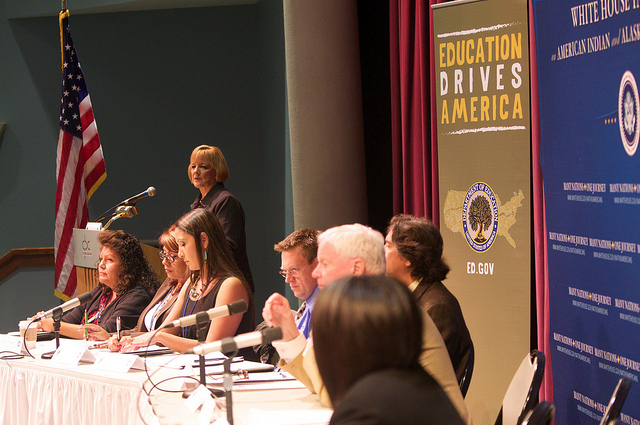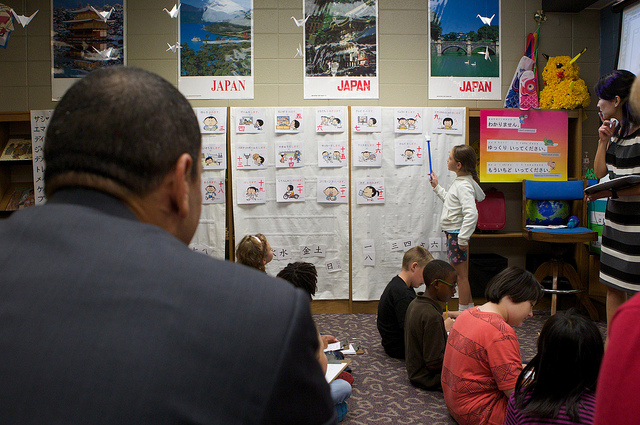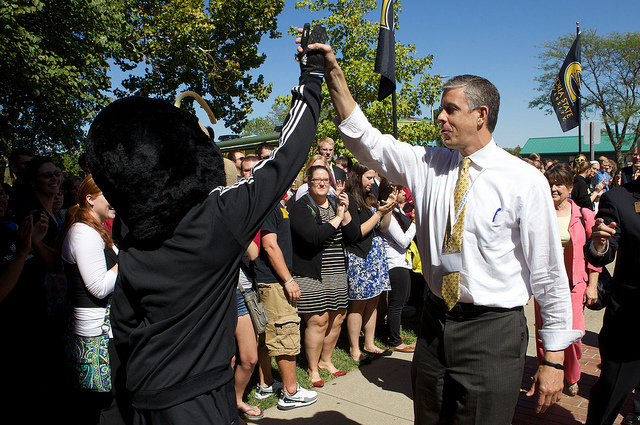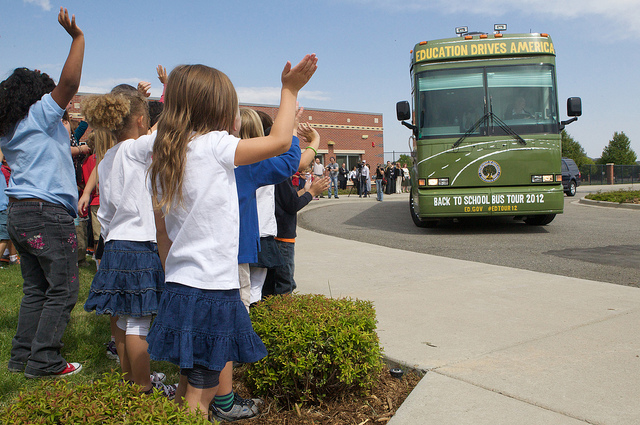Over eighty meetings with teachers and school leaders in a two-week cross-country blitz—not bad work for a team of twelve Teaching Ambassador Fellows (TAFs) working for a year with the U.S. Department of Education.
The Department of Education’s third annual back-to-school bus tour kicked off at Sequoia High School in Redwood City, California on September 12 and culminates with rally at the Department’s plaza on September 21, with nearly a hundred events in between featuring Secretary Arne Duncan and top federal officials. While Secretary Duncan’s appearances have naturally soaked up most of the attention—whether he is dancing at a Denver elementary school for “Let’s Move” or honoring the Topeka, Kansas site of the Brown vs. Board of Education case—TAFs have been hosting intimate events to ensure that educators’ voices are heard.
The Teaching Ambassador Fellowship, now in its fifth year, includes six teachers from across the country on leave from their schools to work full-time for a year with the U.S. Department of Education, and six who remain teaching in their local districts while consulting and conducting outreach part-time with ED. The September bus tour has been a prime opportunity for TAFs to lead important discussions on how to improve student outcomes. As a TAF just six weeks into the fellowship, it was refreshing for me to hear from folks around the country.
The outreach extravaganza started in California as ten current and former Teaching Ambassador Fellows fanned out across the Bay Area to talk with educators. In one memorable event, Seattle-based TAF Kareen Borders hosted a discussion with current and future science teachers at the NASA Ames Research Center. Locales for TAF-led discussions in California included district and charter schools, where teachers weighed in on the Obama Administration’s education agenda, the RESPECT Project for transforming the teaching profession, and their own thoughts on how to increase student learning.
Travelling to over 30 communities in 11 states, TAFs convened teachers in Silicon Valley, Las Vegas and across Wyoming through Louisville, St. Louis and Richmond and many rural communities in between. At Salt Lake City Community College in Sandy, Utah, Arizona-based TAF Cheryl Redfield and I recruited local National Board Certified Teachers to facilitate breakout sessions at a 200-person educational technology summit. At Emporia State University in Kansas, TAF Cindy Apalinski from Linden, New Jersey met with teachers-in-training and introduced Secretary Duncan at a town hall attended by approximately 400 future educators.
Seeking and respecting teacher perspectives must be a crucial part of shaping policies that teachers ultimately implement. Over the past two weeks, Teaching Ambassador Fellows have been on a mission to learn from a wide range of stakeholders from across the country. The next step after the bus tour dust settles is to report back to senior staff and Secretary Duncan.
Here is a sampling of what TAFs heard along the way:
On the importance of great teaching:
“Technology won’t save education; great teachers with great tools will save education.”
“All you need is a teacher and a program to open students’ hearts and minds to help them become global citizens.”
“Never forget how complex the teaching profession is. Great teachers have to make high stakes decisions almost every minute of their day. Any policy changes that try to teacher-proof the curriculum are bound to fail.”
“Middle school STEM is so important because that’s when they are trying to figure out who they are.”
“We can teach students about heroes, or we can create our own heroes.”
On professional development and career paths:
“I love the classroom, but I need opportunities to advance that aren’t taking me away from being in the classroom.”
“We need to be in an ongoing process of growth, professionally, not just stuck as either a ‘new’ educator or an ‘experienced’ one.”
“I would love to stay in the classroom, but can I afford to stay in this pay grade forever? No. So, unfortunately, I will have to leave. I need the opportunity to stay.”
“We want to better ourselves. Let us. Offer teachers the opportunities to advance, not just by seniority or maxing out by credits.”
“Teachers want to be in positions that allow them to learn while they still teach. They want to learn their subject and their craft.”
“Merit pay is okay as long as teachers are evaluated on what we value.”
“Ideally leaders would move into a leadership role, and eventually return to the classroom. However, returning to the classroom would mean a pay cut, and it’s difficult for someone who has ‘lived the life’ to then go back to their old salary.”
“After five years of teaching, I moved into a mentorship role. From there I could really study the profession and study it from an academic standpoint, rather than an emotional one. I really grew from that. We have term limits for mentors to allow more people to do it and to stay in touch with the profession.”
“We don’t just need mentors at the beginning of our careers—we need them throughout.”
“So much that I’ve learned about good teaching has been by watching great teachers.”
On the future of education:
“The achievement gap won’t be closed by one person working in isolation; we need to work together… a group of teachers together is a real impetus for change.”
“We need to demystify the definition of college and career readiness so that every student can actually attain it.”
“In our work, it’s not that good things aren’t happening; it’s that we aren’t doing the good things enough.”
“Not all education happens in the classroom.”
“We can’t continue to fund schools the way we do and hope to be successful. There’s a possibility of three weeks being cut off our schedule if a sales tax initiative does not pass is November [in California].”
“A huge recruitment issue is respectability—we’re just not respected as teachers, so we need to better educate the public.”
“If we want to improve our schools we need to get back to basics and build relationships in our schools and communities.”
“The idea of a ‘full teaching load’ needs to change. If you asked me what I would ideally be doing, I would teach a 3/5 load full-time, and spend the extra energy on those classes. Class sizes do matter. To think about doing anything else in addition to our full-time load is impossible.”
“It is up to our current and future educators now to lead the country in the direction we need to go.”
On teachers’ realities:
“To go to these meetings where every trainer and attendee has an iPad, but not one of my students does, that’s an issue.”
“I see teachers working their hearts out, one kid at a time.”
“Data doesn’t say what relationships make happen.”
“Our country’s acceptance of mathematics illiteracy is appalling.”
“We have too many things to do, so we can’t do any of them well, and especially not with a 32 minute planning period.”
“We need leaders who make us feel wanted, valued. We need to know our input is valued… we also need this among ourselves, letting each other know that we’re valued and respected.”
“Collaboration is about trust.”
“Teachers don’t operate in a vacuum and kids need lots of other support service to survive. From psychological help, to breakfast programs, to extra support for struggling students, to basic health needs. If that’s not available, no matter how good of a teacher you are you are not able to get the best from students.”
“At one point my contract said that I taught 20% mentored 80%, but in reality the teaching part actually took 75% of my time and 90% of my emotional space. Serving as a leader and a teacher I asked myself the following question, “If you’re teaching, can you do anything else well at the same time?”
Dan Brown is a Teaching Ambassador Fellow at the U.S. Department of Education for the 2012-13 school year. He is a National Board Certified Teacher at The SEED Public Charter School of Washington, D.C.

 Assistant Secretary Delisle’s career has been dedicated to students across the country. Starting her elementary and middle school teaching career in Connecticut, she later moved to Ohio where she served as a gifted education specialist, curriculum director, elementary principal, associate superintendent and superintendent.
Assistant Secretary Delisle’s career has been dedicated to students across the country. Starting her elementary and middle school teaching career in Connecticut, she later moved to Ohio where she served as a gifted education specialist, curriculum director, elementary principal, associate superintendent and superintendent.



















